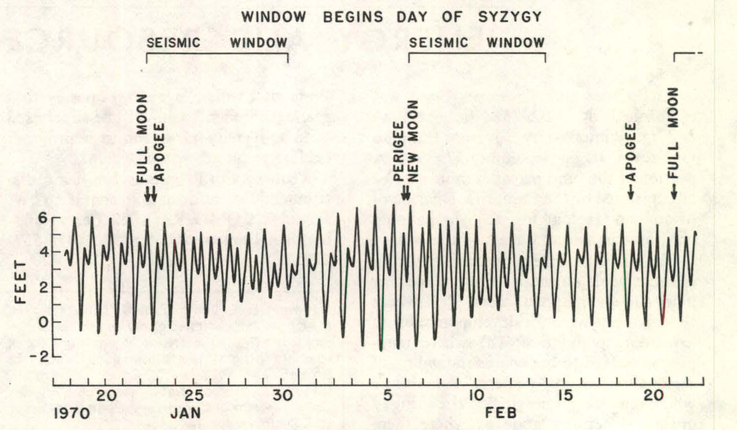Tidal triggering on:
[Wikipedia]
[Google]
[Amazon]
 Tidal triggering of earthquakes is the idea that
Tidal triggering of earthquakes is the idea that Volcano watch
 Tidal triggering of earthquakes is the idea that
Tidal triggering of earthquakes is the idea that tidal forces
The tidal force is a gravitational effect that stretches a body along the line towards the center of mass of another body due to a gradient (difference in strength) in gravitational field from the other body; it is responsible for diverse phenomen ...
may induce seismicity
Seismicity is a measure encompassing earthquake occurrences, mechanisms, and magnitude at a given geographical location. As such, it summarizes a region's seismic activity. The term was coined by Beno Gutenberg and Charles Francis Richter in 19 ...
.
In connection with earthquakes, syzygy refers to the idea that the combined tidal effects of the sun and moon – either directly as earth tide
Earth tide (also known as solid Earth tide, crustal tide, body tide, bodily tide or land tide) is the displacement of the solid earth's surface caused by the gravity of the Moon and Sun. Its main component has meter-level amplitude at periods of a ...
s in the crust itself, or indirectly by hydrostatic load
Fluid statics or hydrostatics is the branch of fluid mechanics that studies the condition of the equilibrium of a floating body and submerged body " fluids at hydrostatic equilibrium and the pressure in a fluid, or exerted by a fluid, on an imm ...
ing due to ocean tides – should be able to trigger earthquakes in rock that is already stressed to the point of fracturing, and therefore a higher proportion of earthquakes should occur at times of maximal tidal stress
The tidal force is a gravitational effect that stretches a body along the line towards the center of mass of another body due to a gradient (difference in strength) in gravitational field from the other body; it is responsible for diverse phenom ...
, such as at the new and full moons.
Previously, scientists have searched for such a correlation for over a century, but with the exception of volcanic areas (including mid-ocean spreading ridge
A mid-ocean ridge (MOR) is a seafloor mountain system formed by plate tectonics. It typically has a depth of about and rises about above the deepest portion of an ocean basin. This feature is where seafloor spreading takes place along a diver ...
s) the results have been mixed. It has been suggested that some negative results are due to failure to account for tidal phase and fault orientation ( dip), while "many studies reporting positive correlations suffer from a lack of statistical rigor." One systematic investigation found "no evidence for an increase in seismicity during intervals of large tidal range but there is clear evidence for small but significant increase in earthquake rates near low tide"; it did not find an increase of earthquakes near peak spring tides. Seismicity is favored at low tides, particularly for reverse fault
In geology, a fault is a planar fracture or discontinuity in a volume of rock across which there has been significant displacement as a result of rock-mass movements. Large faults within Earth's crust result from the action of plate tectoni ...
s, because unloading unclamps the fault, reducing friction. Ocean loading has no effect at all on strike-slip faults.
Research work has shown a robust correlation between small tidally induced forces and non-volcanic tremor activity.
Volcanologists use the regular, predictable Earth tide movements to calibrate and test sensitive volcano deformation monitoring instruments. The tides may also trigger volcanic events.
USGS
The United States Geological Survey (USGS), formerly simply known as the Geological Survey, is a scientific agency of the United States government. The scientists of the USGS study the landscape of the United States, its natural resources, a ...
.
See also
* Earthquake prediction#1990: New Madrid, U.S. (Browning) * Jim Berkland#Methodology *Love numbers
The Love numbers (''h'', ''k'', and ''l'') are dimensionless parameters that measure the rigidity of a planetary body and the susceptibility of its shape to change in response to a tidal potential.
In 1909, Augustus Edward Hough Love introduced ...
*Tidal effect on plate tectonics
Plate tectonics (from the la, label=Late Latin, tectonicus, from the grc, τεκτονικός, lit=pertaining to building) is the generally accepted scientific theory that considers the Earth's lithosphere to comprise a number of large ...
Notes
Sources
*. *. *. *. *. *. Tides Types of earthquake {{seismology-stub